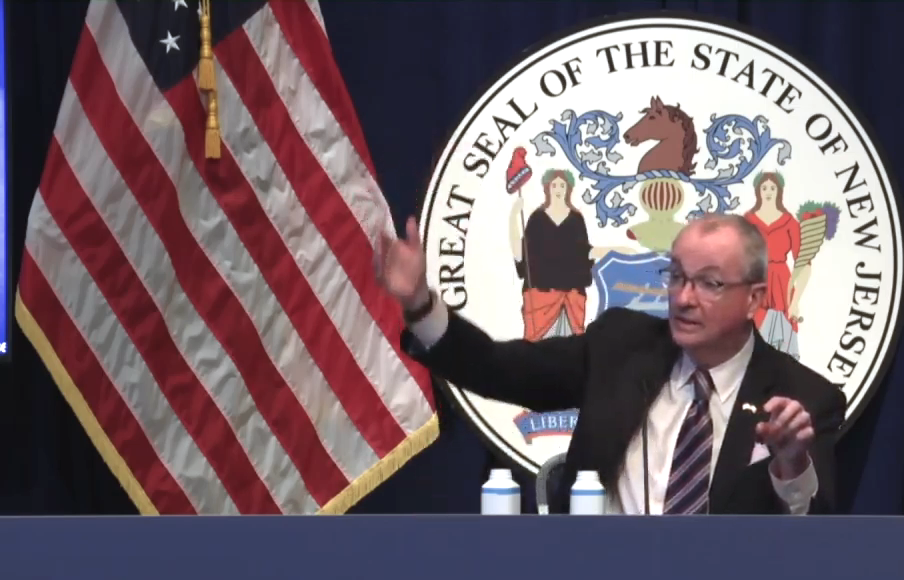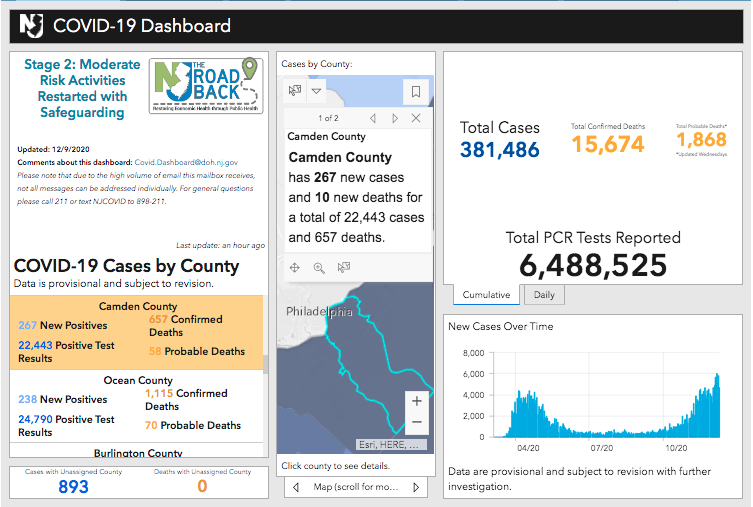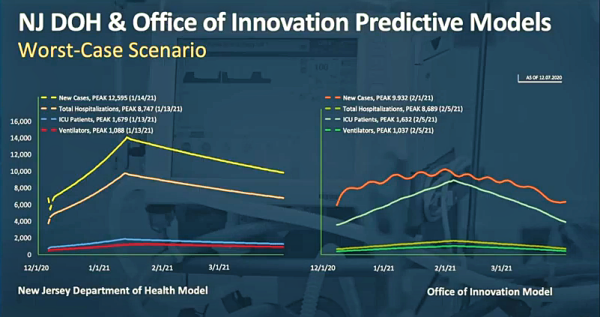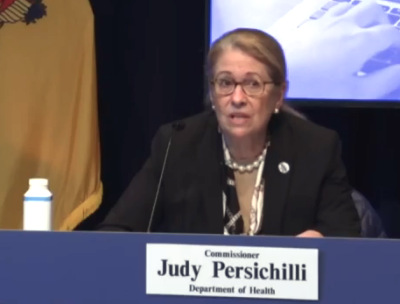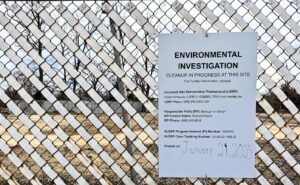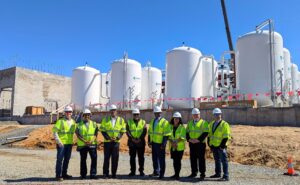If New Jersey residents return to levels of compliance seen in the spring, the peak of the surge could be pushed to early February, officials say. Plus: more resources for those who need support quarantining.
By Matt Skoufalos | December 9, 2020
Another 4,665 New Jersey residents have tested positive for novel coronavirus (COVID-19), bringing the statewide total to 381,486 cases, Governor Phil Murphy reported Wednesday.
Sadly, 91 more residents have perished from complications related to the virus, bringing the statewide death toll to 15,674 lives lost during the pandemic.
In addition to those lab-confirmed fatalities, the state has acknowledged another 1,868 probable COVID-19-related deaths, up by 32 from prior counts.
Since March, 487 of every 100,000 New Jersey residents have been hospitalized with COVID-19, and 177 of every 100,000 have died from COVID-19-related complications.
More than 6.48 million polymerase chain reaction (PCR) tests for COVID-19 have been performed statewide, with a 4.29-percent positivity rate per 100,000 residents.
Rate of transmission (Rt) at 1.10, spot positivity highest in South Jersey
The statewide average of COVID-19 spot positivity testing stood at 13.18 percent December 5; in South Jersey, it was highest, at 14.67 percent.
Rt, the variable that describes the seven-day, rolling-average, statewide rate of transmission of new COVID-19 cases, rose to 1.10 from samples taken December 7.
An Rt figure greater than 1.0 means that each new COVID-19 patient is infecting more than one other person, on average, and the spread of the virus is increasing.
Since its mid-April COVID-19 spike, the highest reported RT in New Jersey was 1.48, recorded August 1. The lowest was 0.62, recorded June 9.
Hospitalizations continue to follow new infections
Throughout New Jersey, 3,533 people currently are hospitalized with a suspected (271) or confirmed (3,262) case of COVID-19, Murphy said.
Yesterday 446 COVID-positive patients were admitted to New Jersey hospitals, while 397 were discharged.
Among those hospitalized patients, 630 were in intensive or critical care, and 412 of the ICU and critical-care patients (65 percent) are on ventilators.
“There is a direct cause-and-effect relationship across the board: the more people who contract the virus, the more people who will eventually need hospitalization,” the governor said: “a subset, intensive care; a subset further, ventilators; and sadly, a subset who we’ll lose.
“It is the numbers in our hospitals which are of the greatest concern, and the hardest numbers when it comes to determining the steps we need to take as a state,” he said.
Across the state, long-term care (LTC) centers have reported 1,076 cumulative outbreaks of COVID-19, and 380 are dealing with an active outbreak. LTCs account for 44,483 infected patients and staff in New Jersey, or 12 percent of total cases.
That includes 27,652 residents and 16,831 staffers sickened by the virus, as well as 7,359 lab-confirmed resident and staff deaths (47 percent of the statewide total), with facilities self-reporting 122 staff deaths.
Of 656 veterans residing in three state-run homes, 411 have tested positive for COVID-19, and 147 have died from complications related to the virus. Nine veterans presently are hospitalized with COVID-19, and 250 have recovered from the virus.
At state-run psychiatric facilities, 267 of 1,172 patients and 684 staff members have tested positive for COVID-19. Fourteen patients and seven staffers have died from complications related to the virus.
To date, 64 New Jersey children aged 1 to 18 have been diagnosed with pediatric multi-system inflammatory syndrome.
All those pediatric patients have tested positive for an active COVID-19 infection or the presence of COVID-19 antibodies, indicating exposure to the virus. No deaths have been associated with this syndrome in New Jersey, although several children have been hospitalized during their treatment.
Since August 1, 88 COVID-19 outbreaks encompassing 388 individual cases have been traced to schools in 19 New Jersey counties. In Camden County, 12 outbreaks have been linked to 63 cases, second-most in the state.
Statewide, 87 New Jersey schools are open for fully in-person instruction, 423 are operating a hybrid model of remote and in-person instruction, 258 are fully remote, and 43 are operating with a mix of all of the above.
Pandemic modeling scenarios
On Wednesday, Murphy introduced a pair of predictive models, developed by the New Jersey Department of Health (NJDOH) and Office of Innovation, respectively, which forecast the next peaks of COVID-19 infections, hospitalizations, critical care, and ventilator usage.
Both models assume no change in current levels of public compliance with social distancing and mask mandates, no alteration to traditional holiday gathering plans, and limited impact from the early distribution of COVID-19 vaccines.
The NJDOH model predicts a second-wave peak in new infections (12,595) on January 13, and peaks in hospitalizations (8,747), critical-care patients (1,679) and those on ventilators (1,088) January 14—two weeks after New Year’s Eve (January 14, 2021).
The New Jersey Office of Innovation model predicts a second-wave peak in new infections (9,932) on February 1, and peaks in hospitalizations (8,689), critical-care patients (1,632) and those on ventilators (1,037) on February 5.
(For comparison, during the spring months, the hospitalization peak in New Jersey came April 14, with 8,270 patients in hospital, 2,051 in an ICU bed, and 1,872 on ventilators.)
The NJDOH model predicts different rates of hospitalization based upon trends established after holidays throughout the pandemic, as well as assuming a 100-percent conversion of persons under investigation (PUI) to a confirmed case of COVID-19.
The Office of Innovation model features an “oscillating Rt” variable, and turns on how those transmission rates influence hospitalizations, Persichilli said.
“What these two models show us is that under each scenario, we are under weeks of significantly increasing cases,” Murphy said.
However, the scenario envisioned by NJDOH could foretell more stringent restrictions from the state government, which “would have no choice but to act” in response to those reports, the governor said.
If the data bear out the Office of Innovation model, under which “all of us do a little more,” including increased masking, social distancing, and limiting gatherings to immediate household members, the state can avoid additional restrictions, Murphy said.
“If we do that, we will have put ourselves in a more promising position for when a vaccine becomes more widely available in the spring, and that means we can begin lifting restrictions that much sooner,” he said.
“Let’s get the magnitude of the surge down so it’s much more manageable, and then as the vaccines come online, that combination is a really good, lethal combination of a lower infection spread, a lower scale of the pandemic, and vaccines coming in in tranches of hundreds of thousands, if not more, a week, coming in,” the governor concluded.
Additional supports available for quarantining, small business PPE purchases
In all 21 counties, NJDOH has funded social support coordinators for New Jerseyans who must quarantine after a positive COVID-19 diagnosis, Persichilli said.
Coordinators can help residents get into a safe place to quarantine as well as with food, income, child care, prescription medicine, housing, health insurance, legal aid, and mental health services. They work with contact tracers to help determine who needs what supports, making cooperation with contact tracing even more valuable for state residents, she said.
Finally, the discount program for small businesses purchasing personal protective equipment (PPE) through the New Jersey Economic Development Authority (NJEDA) has been extended to December 17. For details, click here.

